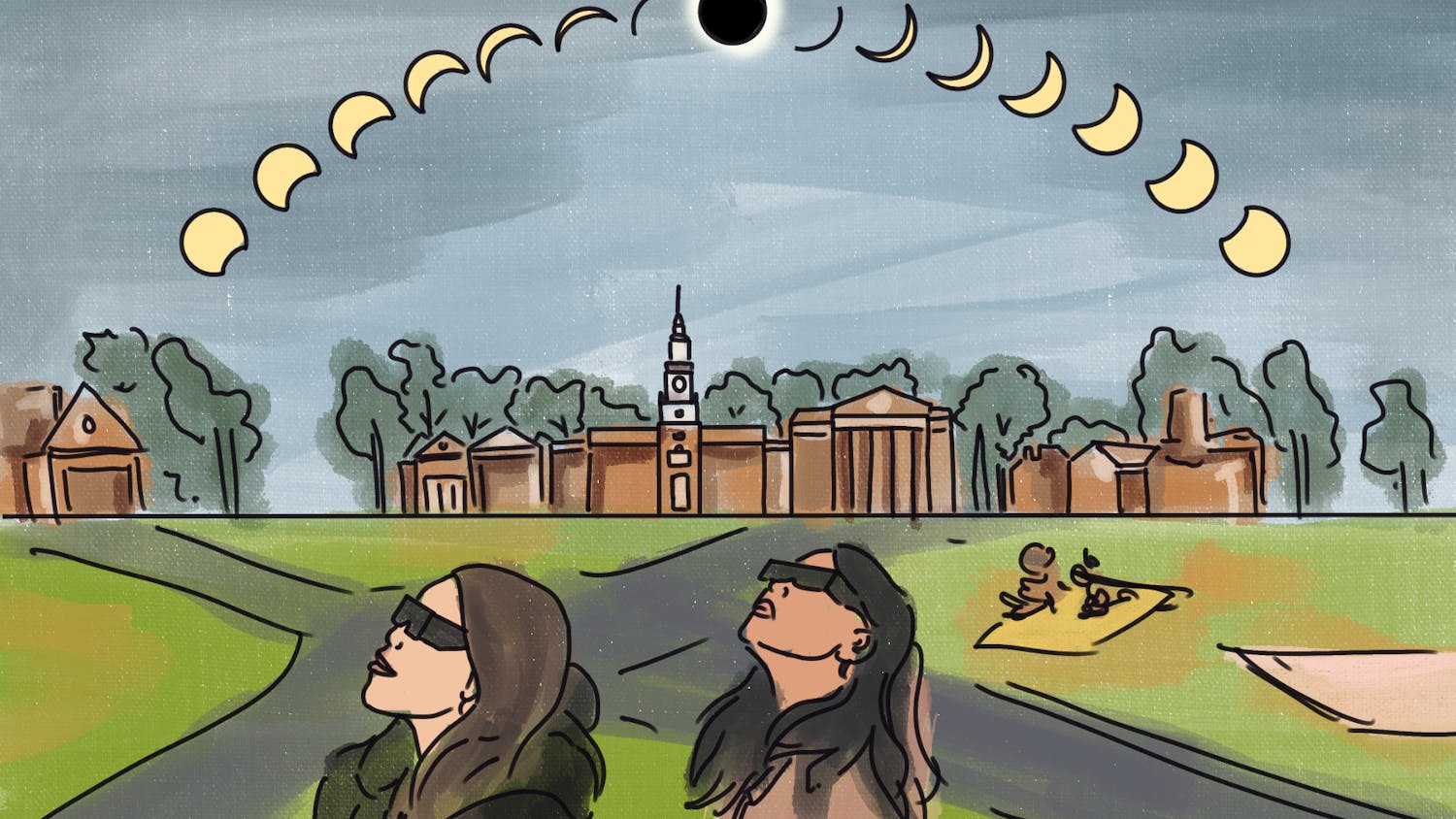Members of an improv group stand on the first floor a fraternity, doing a humorous skit. The audience members are visibly entertained, smiling and laughing. Suddenly, caught up in the moment, a member of the improv group makes a joke that some might deem offensive or politically incorrect. The audience members’ expressions turn to ones of discomfort and distaste, some letting out nervous laughter and others whispering to their friends. Other members of the improv group continue on, glossing over the awkward and tense moment.
Humor comes in many forms and from a variety of people. Sometimes humor serves an everyday purpose, to cure boredom. Other times, it can be used as a political tool, to criticize oppressive regimes. However, who is able to judge what is humorous and what is not? Can humor veer on being offensive — or is the very purpose of humor that nothing is offensive?
No matter the medium, author or subject, humor serves to connect us all, and here at Dartmouth we have access to a wide variety of humor. The most well-known and popular form here is probably improvisational comedy groups.
Walker Schneider ’19 , a member of the long form improv group Dog Day, explained the differences between long form and short form improv. He said the main difference is the length of time and the depth of the skit.
“Short form is about quick witted humor,” Schneider said. “The members play a two minute game, and the game facilitates the humor. In contrast, long form improv is about building a scene, usually with only two people performing at a time. Thus, jokes take longer to develop.”
At Dartmouth, Dog Day contrasts with Casual Thursday, which is a short form improv group. Schneider jokingly spoke to a low-level rivalry between the two groups before describing his personal process for preparing for shows. He said he tries to go in with absolutely no plans in mind.
“Before performing, I actually try to clear out my mind,” Schenider said. “I want to avoid going into the show with any pre-existing ideas.”
Terren Klein ’17 , also a member of Dog Day, explained that this is typical of improv techniques. It’s not a prepared comedic skit, Klein said, but an attempt to spontaneously portray realistic situations that are humorous.
“In improv, I have found that the goal is not really to make jokes, but to create a realistic, grounded world with your scene partner, and once you have done that, the jokes — or to put it simply, unexpected breaks from reality — follow suit,” Klein said. “By definition, improv doesn’t require any forethought or traditional rehearsing.”
Emily Everhard ’18 , a member of Dog Day, said she simply draws inspiration from daily life and her everyday interactions with both friends and strangers. She said this engenders heightened awareness about her surroundings.
“Being in improv makes you more aware of the world,” Everhard said.
Drew Zwetchkenbaum ’16 , co-editor of the satirical campus magazine the Jack-O-Lantern, and president of Casual Thursday, agreed with Schneider, Klein and Everhard about the origin and inspiration for humor. He also remarked that everything and anything can be turned into a joke.
However, these students all agreed that there are certain limitations on what they can or cannot joke about.
Klein explained that sometimes they have to somewhat adjust their jokes and style of humor to their audiences, although this shift might not always be deliberate.
“The adjustment probably occurs on a subconscious level if anything,” Klein said. “As a group, we try not to make any real life references in our shows so that our humor can be understood by anyone.”
However, he noted since their audiences can vary so significantly, some adjustment is inevitable — and even necessary.
"With that being said, there is certainly a difference between performing in front of a buzzed KDE crowd and performing at a homeless shelter in the Upper Valley,” Klein said. “In the former case, our humor might be described as more uninhibited than in the latter.”
He said this is often due to audience reactions, which improv groups must assess in order to determine what kind of humor to use.
“Above all, we try not to pander to audiences, but we definitely feed off of and reflect the unique energy each crowd gives off during a show,” Klein said.
In terms of the existence of Dartmouth-specific humor, he was hesitant of generalizing humor preferences for the entire student body.
Zwetchkenbaum had a different view, saying that there is a specific kind of humor for Dartmouth students, which is somewhat more diverse than that at other colleges.
“Dartmouth students have a different kind of humor compared to the general U.S. population,” Zwetchkenbaum said. “For example, at times, it’s probably more intellectual. Dartmouth has a mix of satirical and free form humor. Some schools only have satirical publications.”
Zwetchkenbaum said that there are a couple of limitations in comedy in general, but how it’s received depends largely on how it’s delivered.
“You can make a joke about whatever you want, but you are at the mercy of your audience, have to be willing to accept whatever the response is,” he said. “You can make smart, tasteful jokes about just about anything, as long as you frame it in the right way. It’s all about the execution.”
However, Zwetchkenbaum did concede that there are some sensitive topics that comics tend to stay away from, unless for the shock value.
“There are touchy subjects, which some people like to make jokes about, but it’s more for the shock value, it’s not necessarily smart comedy or good comedy,” Zwetchkenbaum said.
Since the Jack-O-Lantern has an audience made up of mostly Dartmouth students with similar perspectives to the authors in the publication, Zwetchkenbaum said that there were no incidents that he could think of with regard to backlash from an audience. He said that, conversely, there are more risks with making jokes in improv shows. He said this is due to it’s improvisational nature — people can’t think through their jokes very thoroughly before they say them.
“Improv is dangerous because you’re at the mercy of your own mind, you need to sort of trust your subconscious to get the jokes out,” he said. “You don’t always have complete control of that.”
He said members are at the mercy of audience members, who can sometimes be sensitive about what they find offensive.
“The audience has the right to be offended by anything they want,” Zwetchkenbaum said. “Anyone has the right to take offence at whatever.”
He found humor to be a double edged sword. When used effectively, though, he explained that it can really help others.
“Humor can bring up victims because it can bring down oppressors,” he said. “There’s a lot of status involved, so it’s unwise to poke fun at victims, that’s kind of like cheating. It’s not using the status inherent in comedy effectively.”
Jacob Savos ’16 , president of the Jack-O-Lantern, agreed with his co-editor Zwetchkenbaum. He said that although the Jack-O-Lantern had never faced any major backlash for publishing offensive content, he explained that if students took issue with what an article said, the editors would take it seriously and reevaluate the article’s content.
With regard to improv comedy, Klein brought up a similar kind of cautiousness. He described two types of limitations that improv groups face, the first being that members need to have diverse comedic backgrounds and styles.
“There are two types of limitations on what kind of jokes we can make,” Klein said. “First, just like any creative endeavor, our final product will only be as diverse as the range of experiences each improviser brings to the stage. Therefore, it is a major priority of Dog Day to recruit members with various styles of humor and backgrounds into the group, and there will always be work to be done on this front.”
The second limitation, he explained, is imposed externally by what is politically correct. He said this type of debate is not uncommon on college campuses.
“The second kind of limitation is externally imposed by the culture of our campus,” Klein said. “Not to regurgitate the remarks of certain comedians, like ‘Seinfeld’ or Chris Rock, regarding the PC culture at campuses around the country, but I definitely agree with the overall sentiment that there is a problem with how comedy is being received today on campuses.”
Klein explained a simple measure to assess whether or not as joke is appropriate.
“If a joke concerning a particularly controversial topic evokes laughter at the expense of the victim and ignores the perpetrator, then the joke is probably a bad one,” Klein said.
Schneider explained a similar rule of thumb, noting that he tries to refrain from using excessive profanity.
“There are some lines you don’t want to cross. You don’t want to rely on shock value for laughter,” Schneider said. “For example, relying on dropping a bunch of f-bombs isn’t really high end comedy.”
Dog Day relies on “staying grounded” and starting out with something more normal or out of daily life, then becoming increasingly absurd and ridiculous.
“There’s no distinct line, like ‘you can’t swear, you can’t make jokes about misogyny,’ but generally we follow the norms of conversation,” Schenider said.
He said the only backlash he has received was not from an audience member but was from an older member of his comedy group, advising him against using profanity.
She told him not to use offensive language as a “crutch” for his jokes.
Overall, the students had difficulty deciding on a specific line to draw when it comes to making jokes.
“There’s a lot of bad stuff that happens in world, and humor can be a great way to contextualize and criticize it,” Zwetchkenbaum said.



